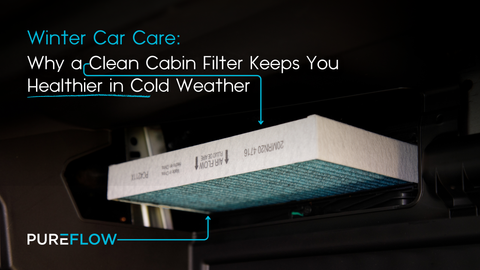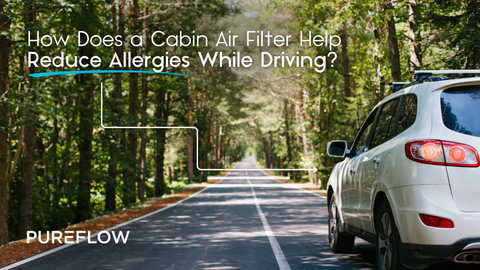Air filters are an integral part of all modern ventilation systems, preventing unwanted dust and other particles from entering the ‘clean’ environment of your home, office, or car. The designs and technology behind them have been the subject of constant improvement, providing filtration of ever-smaller particles, removal of noxious smells, and improving the overall turnover of air within the system.
Although the basic technology behind car and home filters are similar, the actual implementation is quite different. While an engineer can easily add a new filtration system onto a building, space within a car is far more limited – thus the design of automotive HVAC filters places a stronger emphasis on compact size. At the same time, automotive filters need to remove the high levels of particles and unwanted odours which are associated with major roads, particularly in crowded city environments. Thankfully some things are easier for automotive engineers – the smaller size of the cabin compared to an entire building means that complete air turnover is much easier to achieve.
The major parameter for any HVAC system is known as clean air delivery rate (CADR), the amount of clear air which can be pushed into the area at any one time. CADR is based on the flow rate (how much air is being pushed through the system) and the performance of the filter (how much junk is being removed from that air by the filter). We’ll cover these factors in more detail in another article, but for now it’s important to know that both are important for the quality of the system.
Filters, both for the home and the car, come in a number of different formats and types. The most common air filters are basic particulate filters, usually made of finely folded paper – this is cheap, reliable, and simple to manufacture. At a microscopic level, paper consists of a number of closely-packed cellulose fibres, these fibres are packed loosely enough that air can travel between them, while the far-larger dust particles cannot slip between the fibres and so remain fixed in the filter. This filtration approach is simple and effective, and accounts for the majority of the automotive air filters on the market today.
However, there are some disadvantages to paper filters. In particular, the packing of the fibres strongly affects the size of the material which can be filtered – large pore sizes will allow higher air flow but allow the smallest particles to pass through the filter. This presents engineers with a challenge, they need to filter out small pollutants while still providing adequate CADR. One solution to this problem is the use of electrostatically charged filters. Here the flow of air leads to the build-up of static electricity on the filter fibres – this charge then attracts passing particles from the airstream onto the fibre, holding them in place via electrostatic forces. Charged filters were originally developed for large office HVAC systems, but soon started appearing in automotive filter systems.
For truly effective particle removal, most HVAC systems turn to HEPA filters – which are required to remove 99.97% of particles 0.3µm in diameter (the most challenging size for all filtration units). Although highly effective in hospital or laboratory settings, HEPA filters are usually overkill for the average vehicle. HEPA filters have higher “DeltaP” (Drop in Pressure) and thus require significantly more powerful motor to achieve the same level of air-flow – this leads to particular challenges when replacing a standard filter with HEPA, as the air blower was designed to meet different requirements, which results in reduction of the overall clean air delivery rate. In reality, very few cars actually use a HEPA-rated air filtration system. One of the few models to consistently use HEPA filters as a secondary filter the ventilation system in Tesla Model-X and Model-S.
HEPA is quite effective in blocking particulate matter, however it is incapable of blocking harmful gasses, chemical traces or odour molecules. To prevent this, engineers turn to activated carbon. Regularly used in air and water filters, activated carbon is essentially finely-ground pieces of charcoal. These particles are very small, yet have a exponentially large surface area, which increase it ability to bind to passing molecules. Charcoal has exceptional absorption capacity for its size, which has led it to be incorporated into home and car HVAC systems as an odour-absorbing system.
Antimicrobial properties are not themselves a filtration method, but are enhanced technologies that can be included in the filter to improve the overall airflow quality. This can be achieved in a number of ways, but the most common is to include nano particles of metal such as copper or silver. Both have highly reactive ionic forms and a natural tendency to produce reactive oxygen species. Reactive oxygen species gleefully destroy bacterial cells and DNA, making it a remarkably effective way to sterilise the air flow. Interestingly, the antibacterial properties of metals such as copper have been known for many years – indeed mediaeval churches in Germany often had copper strips on the backs of the pews to help worshippers to sterilise their hands, and so prevent disease spreading throughout the community. Despite this long history, however, metal-impregnated systems are only recently becoming part of automotive filter design pioneered by PureFlow.
PureFlow uses a combination of filtration methods to provide clean air. This includes several different layers of filters, starting with an electrostatically charged fibre layer for particle filtration, an activated charcoal with baking soda for absorption of odours and other chemicals, and a copper/silver ions infused layer to inactivate viruses and bacteria. This highly-effective combination has been shown to provide exceptionally clean air for passengers and drivers.
You can find the right filter by using our search feature now! Read more about cabin filters and then find a great filter for your car.

















































